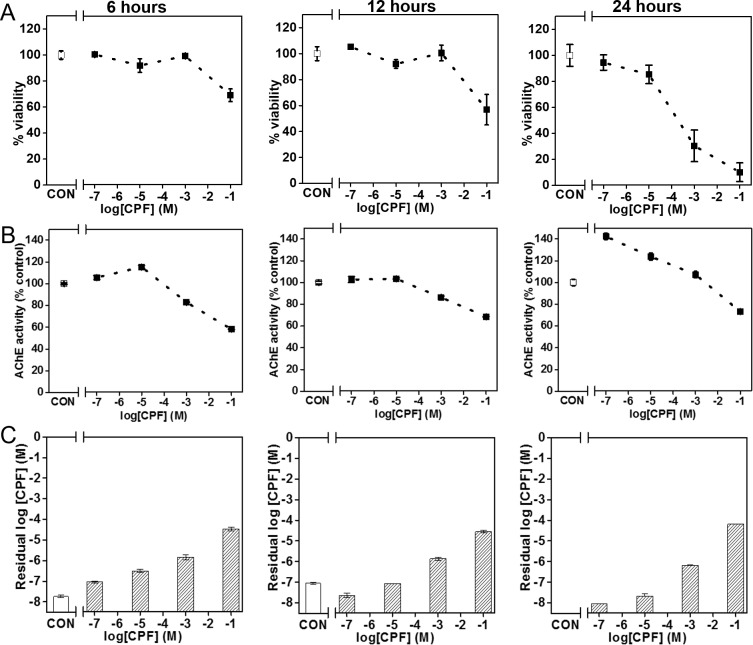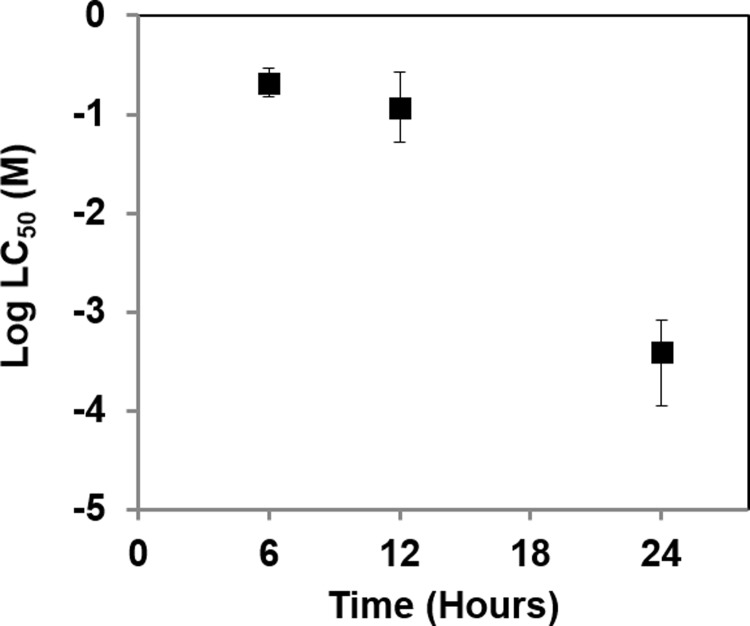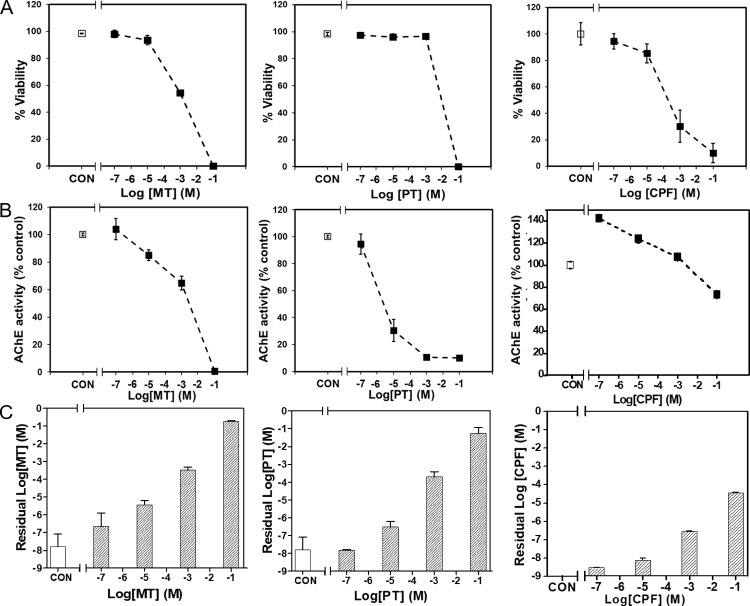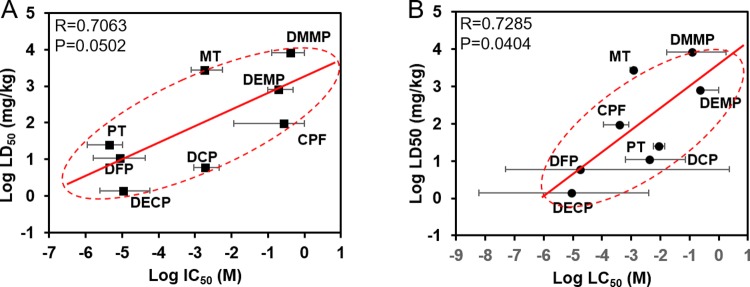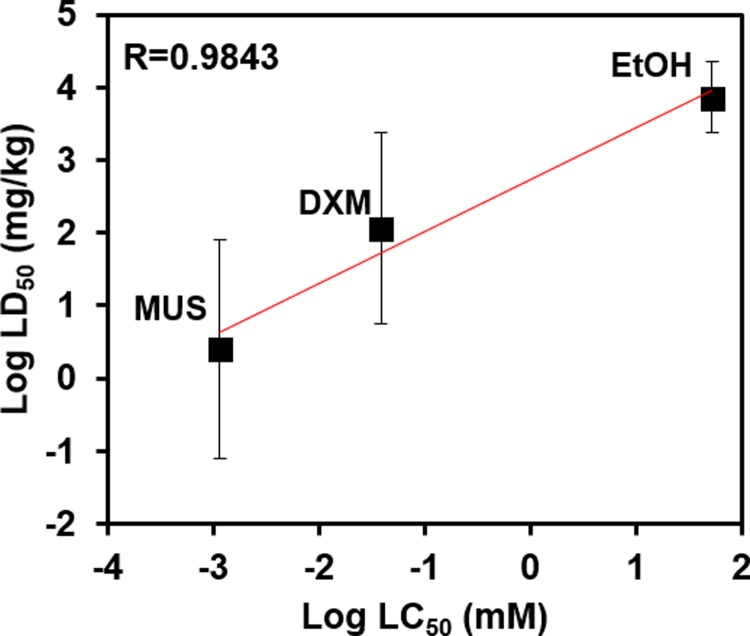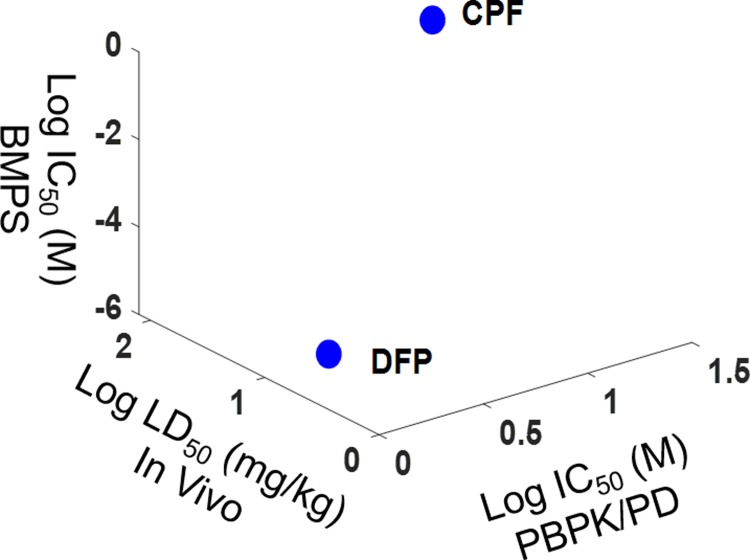Abstract
We investigated a potential use of a 3D tetraculture brain microphysiological system (BMPS) for neurotoxic chemical agent screening. This platform consists of neuronal tissue with extracellular matrix (ECM)-embedded neuroblastoma cells, microglia, and astrocytes, and vascular tissue with dynamic flow and membrane-free culture of the endothelial layer. We tested the broader applicability of this model, focusing on organophosphates (OPs) Malathion (MT), Parathion (PT), and Chlorpyrifos (CPF), and chemicals that interact with GABA and/or opioid receptor systems, including Muscimol (MUS), Dextromethorphan (DXM), and Ethanol (EtOH). We validated the BMPS platform by measuring the neurotoxic effects on barrier integrity, acetylcholinesterase (AChE) inhibition, viability, and residual OP concentration. The results show that OPs penetrated the model blood brain barrier (BBB) and inhibited AChE activity. DXM, MUS, and EtOH also penetrated the BBB and induced moderate toxicity. The results correlate well with available in vivo data. In addition, simulation results from an in silico physiologically-based pharmacokinetic/pharmacodynamic (PBPK/PD) model that we generated show good agreement with in vivo and in vitro data. In conclusion, this paper demonstrates the potential utility of a membrane-free tetraculture BMPS that can recapitulate brain complexity as a cost-effective alternative to animal models.
Introduction
Chemical agents like organophosphates (OPs) pose a grave threat to soldiers, creating an urgent need to develop better in vitro models for studying neurotoxicity screening, as well as developing protective measures against chemical warfare agents and therapeutic interventions. Further, more than 60,000 tons of OP pesticides are produced and used every year in the United States, which poses a significant potential health risk [1]. OPs are usually ester (R-CO2-R), amide (R-NH2), or thiol (R-SH) derivatives of phosphonic acid (H3O3P). OPs inhibit acetylcholinesterase (AChE), leading to an accumulation of acetylcholine (ACh) that induces hypercholinergic activity as a result of continuous firing between pre- and post-synaptic neurons. This process causes lethal excitotoxicity, seizures, and brain damage [2, 3]. Another set of warfare agents are chemicals that interact with GABA and/or opioid receptors, which can cause acute neurotoxicity. There is a clear need to develop a realistic in vitro brain microphysiological system (BMPS) that recapitulates the activities, mechanical environment, and complex physiological responses of the brain and that can be used to rapidly screen large numbers of chemical warfare compounds.
Current 2D in vitro models do not reliably model nor predict brain physiology and do not recapitulate the continuous interaction of multiple tissues in the central nerve system (CNS). Transwell models, which use static cultures in multiple compartments separated by a rigid, porous membrane, have limited imaging capability and vascular function. Similarly, brain slices may provide a certain level of brain circuit function, but cannot replicate the complex, multifunctional, and integrated neuro-gliovascular-immune system needed for toxicity screening. Recently, organoid and spheroid models have been used to study brain development and dysfunction. There is a clear need to develop a dynamic 3D BMPS that can provide clinically relevant information for toxicity screening. Brain tissue models must (i) include different cell types, such as neurons, microglia, astrocytes, and endothelial cells with host extracellular matrix (ECM), and (ii) be able to replicate the spatiotemporal context of original brain tissue.
In a previous study, we successfully screened four OPs for neurotoxicity using a 3D tetraculture microphysiological platform [4]. In this paper, we use the same platform to screen the toxicity of an expanded set of OPs and chemical agents that interact with GABA and/or opioid receptors: agonists of GABA receptors Muscimol (MUS) and Ethanol (EtOH), and glutamate (NMDA) antagonist Dextromethorphan (DXM). We evaluated the neurotoxic agents for concentration-dependent effects on: 1) overall cell viability/toxicity, 2) penetration of the agents across the model blood brain barrier (BBB), and 3) inhibition of AChE activity in target neuron cells following exposure. We correlated the in vitro results with available in vivo data for the potential use of this platform in a high-content/throughput manner. Furthermore, we developed an in silico physiologically-based pharmacokinetic/pharmacodynamics (PBPK/PD) model to predict effective concentrations and correlated our results with the in vitro and in vivo data.
Material and methods
Chemical agent preparation
OPs Chlorpyrifos (CPF), Malathion (MT), and Parathion (PT) were purchased from Sigma-Aldrich (St. Louis, MO, USA) in neat form. They were dissolved in Dimethyl sulfoxide (DMSO) first, and then diluted to final concentration of 5% DMSO in Dulbecco’s modified eagle’s medium (DMEM, ATCC, Manassas, VA, USA) and then further diluted in DMEM to concentrations of 10−1, 10−3, 10−5, and 10−7 M. Muscimol (MUS, Sigma-Aldrich, St. Louis, MO, USA) and Dextromethorphan (DXM, USP™, Rockville, MD, USA) were diluted in DMEM to concentrations of 10−1, 10−2, 10−3, and 10−4 mM. Pure Ethanol (EtOH) purchased from Sigma-Aldrich (St. Louis, MO, USA) was diluted in DMEM to concentrations of 500, 100, 20, and 5 mM. The DMSO-contained medium were used as control (CON): 5% DMSO in DMEM for OPs, DMEM for MUS, DXM and EtOH.
Cell culture
The complete culture medium for all cell lines was DMEM supplemented with 10% fetal bovine serum (ATLANTA Biologicals, Flowery Branch, GA, USA) and 1% Penicillin/Streptomycin solution (HyClone Laboratories Inc., South Logan, UT, USA). Murine brain cell lines bEnd.3 (endothelial cells), N2a (neuroblastoma cells), and C8-D1A (astrocytes) were purchased from ATCC. Murine brain cell line BV-2 (microglia) was obtained from Dr. G. Jean Harry (National Institute of Environmental Health Sciences, Research Triangle Park, NC). All cell lines were maintained according to provided protocols and previous studies [5]. Briefly, the cells were cultured in 75 cm2 flasks (Corning, NY, USA) separately, and medium was refreshed every other day until the cells reached ≥ 90% confluency.
3D brain microphysiological system (BMPS)
The OrganoPlate (MIMETAS, Netherlands) was used to construct the 3D membrane-free microfluidic BMPS and the tissue construct method was described previously [4]. Briefly, collagen solution (Corning, Type I Rat Tail) was diluted in DMEM and the pH was neutralized to 7.0–7.4. Collagen preparation was performed on ice. N2a, C8-D1A, and BV-2 cells were re-suspended in the ECM at the following concentrations: N2a – 3.12 x 106 cells/mL, C8-D1A – 3.12 x 106 cells/mL, and BV-2–1.56 x 106 cells/mL. The cell-ECM mixture was added to the gel lane and incubated (37°C, 5% CO2) for 1 h for gel polymerization. After polymerization, bEnd.3 cells were dispensed into the medium lane at a concentration of 1 × 107 cells/mL in DMEM. The plate was incubated against the side of the incubator at a 75° angle for 4 h to allow bEnd.3 cells to settle against the ECM. Then, 50 μL medium was added to the medium inlet and outlet. The plate was placed on an interval rocker (MIMETAS, The Netherlands) for medium perfusion inside the incubator (37°C, 5% CO2). The rocker (switching between +7° and −7° inclination every 8 min) created a bi-directional flow with a mean flow rate of 2.02 μL/min and a mean shear rate of 0.13 Pa. Medium (50 μL each in the inlet and outlet) was refreshed every other day.
Compound exposure and residual measurement
After five days of 3D co-culture, different concentrations of prepared OPs (CPF, MT, and PT), MUS, DXM, and EtOH were added to the medium inlet of the neurovascular endothelial lane (blood lane). After 24 hours, the solution was removed from the blood lane and stored at −20°C. The residual concentrations of the OPs were measured by liquid chromatography with tandem mass spectrometry (LC-MS/MS) using a triple quadrupole mass spectrometer coupled with a Shimadzu Prominence High Performance LC (HPLC) system (API 3200, AB Sciex).
Cell viability
The LIVE/DEAD® Viability/Cytotoxicity Kit for mammalian cells (Invitrogen, Carlsbad, CA) was used to test viability. After washing cells twice with PBS, cells were incubated for 30 min in 2 μM Calcein AM, 4 μM Ethidium homodimer-1 (EthD-1), and 2 μg/mL Hoechst to stain live cells green, dead cells red, and nuclei blue, respectively. Viability was calculated using ImageJ software (US National Institutes of Health, Bethesda, MD) by dividing live cell number by total cell number and multiplying by 100%.
Acetylcholinesterase (AChE) activity assay
The Molecular Probes™ Amplex™ Acetylcholine (ACh)/Acetylcholinesterase Assay Kit was used to measure AChE activity. Briefly, standards and working solutions were prepared according to the manufacturer’s instruction. Samples and standards were incubated in working solution for 30 min. The fluorescence was read using a CLARIOstar microplate reader (BMG LABTECH, Cary, NC, USA) at 25°C.
Data analysis
Cell viability, AChE activity, and residual concentration data (Mean ± Standard deviation) were plotted using Microsoft Excel. The correlation of in vitro AChE activity (inhibitor concentration 50%, IC50) and viability (lethal concentration 50%, LC50) data with in vivo lethal dose 50% (LD50) data was analyzed using Origin® 2018 (OriginLab, Northampton, MA, USA).
Physiologically-based pharmacokinetic /pharmacodynamic (PBPK/PD) model
A PBPK/PD model for AChE inhibition was developed for CPF and diisopropylfluorophosphate (DFP) using MATLAB Simbiology Toolbox. The model has multiple compartments of lung, brain, kidney, liver, diaphragm, slowly perused and rapid perfused tissues, arterial blood and venous blood. In terms of murine-based PBPK/PD modeling of DFP toxicity, this paper followed the previous work from Gearhart et. al. [6], which includes DFP tissue/blood partition coefficients, rates of DFP hydrolysis by esterases, and DFP-esterase bimolecular inhibition rate constants. The model includes two DFP-based esterase reactions: 1) A esterase (AEST) hydrolysis to the non-inhibitory product diisopropylphosphoric acid (DIP) and 2) B esterase (BEST) hydrolysis, which inhibits AChE enzymatic activity. The same determinants were used for the case of CPF and follow previous work [7]. This murine-based CPF toxicity PBPK/PD model with esterase dynamics integrates target tissue dosimetry and dynamic response (i.e. esterase inhibition) describing the uptake, metabolism, and disposition of CPF, CPF-oxon, and 3,5,6-trichloro-2-pyridinol (TCP), and the associated cholinesterase (ChE) inhibition kinetics in blood and tissue following CPF exposure. AEST is allocated to blood, liver, kidney, rapid perfusion, and brain compartments. For both OPs, the hydrolysis reaction is modeled by the Michaelis-Menten kinetics with Vmax and Km parameters measured in-vitro.
Results
Microfluidic 3D BMPS platform
Microfluidic brain tissue chips were constructed using the 2-lane OrganoPlate (MIMETAS, Netherlands), with the construct method previously described [7]. Brain tissue chips consisted of a vascular lane and brain lane with cell-gel matrix, which were separated by a capillary pressure barrier called a phase guide (Pg). The Pg separates the gel and fluid phases for membrane-free endothelial cell adhesion and BBB formation against the cell-gel matrix [8, 9]. The brain tissue constructs were placed on a rocker inside an incubator, creating dynamic medium perfusion in the vascular lane, which consisted of endothelial cells, while the brain lane consisted of neurons, astrocytes, and microglia in ECM.
OP toxicity with different exposure times
Using the BMPS platform, we tested the toxicity of CPF at concentrations of 10−1, 10−3, 10−5, and 10−7 M for 6-, 12-, and 24-hour exposure times. Cell viability, AChE activity, and residual CPF concentration were measured. As shown in Fig 2, cell viability and AChE activity decreased with an increase in CPF concentration and exposure time (Figs 2A and 1B). Residual CPF also increased with an increase in CPF concentration (Fig 2C). The results show that after 6 and 12 hours of exposure, viability decreased from 100% to 60% with an increase in CPF concentration, and at 24 hours, viability dramatically decreased from 100% to 10% (Fig 1A). AChE activity was also greatly impacted after 24 hours (Fig 2B). Fig 3 shows viability (lethal concentration 50%, LC50) decreased with an increase in exposure time.
Fig 2.
Time-dependent viability(A), AChE activity (B), and residual CPF concentration (C) measured in 3D BMPS platform after varying concentrations of CPF exposure.
Fig 1. Brain microphysiological system (BMPS).
(A) BMPS platform design. (a) A Mimetas OrganoPlate consisting 384 wells; (b) The schematic structure of two-lane microfluidic chamber consisting 4 wells; (c) The schematic design (top view) of the observation column; (d) The incubation of OrganoPlate in a dynamic perfusion condition; (e) Expecting cells co-culture after incubation with 220 μm height, 325 μm perfusion lane and 375 μm brain lane. (B) Immunofluorescent images of cells co-culture. (f) Side view of one microfluidic chamber. (g) Live (green)/dead (red) images before OP exposure (nucleus are stained by Hoechst to blue) and (h) after OP exposure (nucleus are stained by Hoechst to blue).
Fig 3. Viability (LC50) after CPF exposure at varying time points (hours) using 3D BMPS platform.
The error bars were shown as 95% confidence intervals (CI) (profile likelihood).
OP toxicity with 24-hour exposure times
We further tested CPF, MT, and PT at four different concentrations (10−1, 10−3, 10−5, and 10−7 M) using the BMPS platform. We measured cell viability, AChE activity, and residual concentration after 24 hours of exposure. The results show that CPF, MT, and PT all penetrated through the BBB and inhibited AChE activity, inducing cell toxicity in the brain tissue construct. The cell viability (Fig 4A) and AChE activity (Fig 4B) of the brain lane decreased with an increase in OP concentration for all three OPs. There was a greater decrease in the AChE activity of cells treated with MT and PT compared to cells treated with CPF. The results show that both MT and PT had higher residual concentrations than CPF (Fig 4C).
Fig 4. OP (MT, PT, and CPF) exposure results with 3D BMPS model.
(A) Viability, (B) AChE activity, and (C) OP residual concentration data. Controls (without OP treatment) are labeled as CON.
In vitro-in vivo data correlation
Our previous study showed an in vitro-in vivo correlation with available toxicity data for four OPs [4]. In this study, we expanded the set of OPs for a more accurate and complete correlation that includes the previous data. Table 1shows a summary of available in vivo LD50 data and our estimated LC50 (viability) and IC50 (AChE activity) data [10–14]. As shown in Fig 5, our estimated LC50 and IC50 show good correlation with in vivo data. Based on our in vitro BMPS model and in vivo data from the literature [15], PT induces greater neurotoxicity than MT and CPF.
Table 1. Comparison of in vitro 3D BMPS model data with in vivo data for OP toxicity.
| Chemical | AChE activity (IC50, M) (95% CI) |
Toxicity (LC50, M) (95% CI) |
In vivo (LD50,mg/kg) (toxicity source) |
|---|---|---|---|
| Chlorpyrifos (CPF) | 2.735E-1 (7.634E-4 ~ noncomplete CI) |
3.949E-4 (1.118E-4 ~ 8.145E-4) |
96 (Oral-human) |
| Malathion (MT) | 1.805E-3 (7.670E-4 ~ 5.600E-3) |
1.171E-3 (9.216E-4 ~ 1.494E-3) |
369 (Oral-rat) |
| Parathion (PT) | 4.338E-6 (1.113E-6 ~ 1.036E-5) |
8.924E-3 (5.727E-3 ~ 1.409E-2) |
25 (Oral-human) |
| Diisopropyl fluorphosphate (DFP) |
1.863E-3 (9.180E-4 ~ 4.635E-3) |
1.781E-5 (5.007E-8 ~ 2.251) |
6 (Oral-rat) |
| Dimethyl methylphosphonate (DMMP) |
4.159E-1 (1.253E-1 ~ noncomplete CI) |
1.217E-1 (1.651E-2 ~ 1.763) |
8210 (Oral-rat) |
| Diethyl methylphosphonate (DEMP) | 1.971E-1 (9.826E-2 ~ 4.933E-1) |
2.307E-1 (2.415E-1 ~ noncomplete CI) |
800 (Intraperitoneal-mouse) |
| Diethyl cyanophosphonate (DECP) | 1.075E-05 (2.475E-6 ~ 5.813E-5) |
8.948E-6 (5.919E-9 ~ 3.906E-3) |
1.4 (Intraperitoneal-mouse) |
| Diethyl chlorophosphate (DCP) | 8.688E-06 (1.603E-6 ~4.302E-5) |
4.094E-3 (6.202E-4 ~ 7.146E-2) |
11 (Oral-rat) |
Fig 5. In vitro AChE activity and viability correlation with in vivo LD50 data.
A. Estimated IC50 for in vitro AChE activity vs. in vivo LD50 for DMMP, DEMP, DECP, DCP, CPF, MT and PT (R = 0.7063, P = 0.0502); B. Log-estimated LC50 for in vitro viability vs. in vivo LD50 for DMMP, DEMP, DECP, DCP, CPF, MT and PT (R = 0.7285, P = 0.0404).
Toxicity of chemical agents that interact with GABA and/or opioid receptors
We screened the toxicity of selected chemical agents MUS and DXM at concentrations of 10−1, 10−2, 10−3, and 10−4 mM and EtOH at concentrations of 500, 100, 20, 5 mM, which were added to the blood lane of the brain tissue chips. After 24 hours of exposure, we found that viability decreased with an increase in concentration for all agents (S1 Fig). MUS decreased viability to a greater extent than DXM at the same concentration. Results also showed that EtOH is much less toxic to the brain compared to MUS and DXM, as it induced similar toxicity to MUS and DXM even though it was added at much higher concentrations. Correlation of our viability data (LC50 and LD50) with available in vivo data for MUS [16], DXM [17], and EtOH [18] was summarized in Table 2. As shown in Fig 6, there is a linear correlation between in vivo data and our in vitro data from the BMPS model (R = 0.9843).
Table 2. Comparison of in vitro 3D BMPS model data with in vivo LD50 data on MUS, DXM, and EtOH toxicity.
Fig 6. Correlation between in vitro viability and in vivo LD50 data.
Log-estimated LC50 for in vitro viability vs. in vivo LD50 for MUS, EtOH, and DXM (R = 0.9843).
In silico PBPK/PD model
A PBPK/PD model was developed for DFP and CPF toxicity based on the Gearhart and Timchalk paper [6, 7]. The PBPK/PD model for DFP and CPF was validated in terms of AChE inhibition and OP concentration change. S2 Fig shows AChE concentration in the blood and brain after IV injection of DFP. AChE increased immediately and decreased in a very short time, ~ 2 minutes, which correlates with existing experimental data in the literature. Next, CPF exposure via IV injection was simulated using a whole-body PBPK/PD model. S3 Fig shows AChE activity after CPF exposure at concentrations of 40 mg/kg, 20 mg/kg, and 1 mg/kg, with results also correlating with previous literature [7]. The results were further correlated with available in vivo data [7, 19, 20] and our in vitro data from the BMPS platform. Fig 7 shows the correlation between in vivo LD50 data and our PBPK/PD IC50 data, which shows good agreement. All results confirmed that DFP is more toxic than CPF.
Fig 7. Correlation between in silico PBPK/PD model IC50, in vitro BMPS IC50, and in vivo LD50 data.
Discussion
Chemical warfare agents and pesticides, including agonists and antagonists of neurotransmitters, can disrupt the CNS and mediate neurotoxicity. In this study, we constructed a BMPS (Fig 1) consisting of 1) ECM-embedded brain cells (neurons, astrocytes, and microglia) and 2) a membrane-free endothelial cell vascular structure with dynamic medium perfusion. This BMPS platform simulated cell-to-cell crosstalk in ECM and BBB physiology in a high-throughput manner [21]. In our previous study, we used this platform to evaluate four OPs for concentration-dependent neurotoxic effects [4]. In this paper, we further validated the BMPS model with an expanded set of OPs and chemical agents that interact with GABA and/or opioid receptors. All the chemicals, including OPs (MT, PT, and CPF) and MUS, DXM, EtOH, penetrated through the simulated BBB and induced neurotoxicity in the ECM-embedded brain cells. For OPs, we tested CPF first to determine its time-dependent toxicity (Figs 2 and 3). As expected, cell viability and AChE activity decreased with an increase in CPF exposure time. Similarly, we performed 24-hour exposures with CPF, MT, and PT and measured OP-induced toxicity. OP toxicity was concentration-dependent and comparable between OPs. The results indicate that CPF is less toxic than MT and PT (Fig 4A and 4B). The residual OP concentration data showed that CPF penetrated the BBB to a greater extent than MT and PT (Fig 4C). In the in vivo-in vitro correlation analysis, a large population of tested samples further validated the reliability of this platform [22]. In vitro results from the BMPS positively correlate with in vivo toxicity. The mechanisms of OP toxicity are not limited to AChE activity inhibition, as they also include other mechanisms, such as glutamate-mediated excitotoxicity, diazion-induced apoptotic neuronal death [23], and mitochondrial-mediated and caspase-regulated apoptosis [24–27]. This also explains the extreme descent in viability but mild decrease even some increase in AChE activity when exposed to Ops (e.g. Fig 3, CPF viability and AChE activity). The BMPS platform we explored here can possibly be a useful model to study complex physiology and toxicity mechanisms. Furthermore, this platform can provide knowledge about the differences between in vitro and in vivo models for neurotoxicology [28].
We tested the toxicity of MUS, DXM, and EtOH at different concentrations, which were determined according to previous studies [29–31]. Cell viability decreased to a greater extent following MUS exposure compared to DXM at the same concentration, indicating that MUS is more toxic than DXM (Fig 6, R = 0.9843). Much higher concentrations of EtOH were needed to attain similar viability results, indicating that EtOH has a much lower toxicity than MUS and DXM. EtOH and MUS are agonists of GABA receptors and the effects of EtOH are not as severe as MUS. The correlation between our viability data and in vivo LD50 data is with a high coefficient in the linear correlation (R = 0.9843). DXM has inhibitory effects on glutamate-induced neurotoxicity as a NMDA receptor antagonist [32]. Previously, researchers have studied the neuroprotective effect of DXM [32, 33], and our toxicity screening study provides a potential dose–dependent model for the toxic or protective effects of DXM. The common mechanism of MUS, EtOH, and DXM is that they inhibit signal transmission and decrease neuron activity, thus disrupting the CNS [34–36]. In regards to this mechanism, MUS is more potent than DXM and EtOH at similar and lower concentrations.
The correlation between available in vivo LD50 data and our simulated AChE IC50 data for DFP and CPF was used to validate our in silico PBPK/PD model. The correlation shows good agreement between in vivo data and our in vitro BMPS data (Fig 7). A comparison of both compounds shows that DFP is more toxic than CPF, which is consistent with previous literature [4]. As more data for the parameters of the PBPK/PD model become available, other chemical agents can be validated in the future.
We confirmed that the BMPS is a feasible, repeatable, and reproducible platform for toxicity screening of chemical agents. The cell viability and AChE activity results from this platform show positive correlation with available in vivo toxicity data. Thus, this platform can be used to reliably predict the in vivo effect, toxic or beneficial, of other candidate compounds.
Supporting information
Viability (%) of brain lane with treatment of MUS (A), EtOH (B) and DXM (C) for 24 hours.
(TIF)
The parameters are cited from literature [19].
(DOCX)
The parameters are cited from literature [19].
(DOCX)
A. Short term within 30 minutes; B. Intermediate term within 1 day; C. Long term over 200 hours.
(TIF)
AChE activity in brain from whole-body PBPK/PD model under CPF, exposure of 40 mg/kg (A), 20 mg/kg (B), and 1 mg/kg (C) within 1 day.
(TIF)
Acknowledgments
The authors thank Drs. Sonia Grego, Brain Hawkins at RTI International (Research Triangle Park, NC, USA), and Dr. Remko van Vught at MIMETAS (Leiden, Netherlands).
Data Availability
All relevant data are within the manuscript and its Supporting Information files.
Funding Statement
This work was supported by U.S. Department of Defense contact # D01 W911SR-14–2–0001–0010 awarded through the MSRDC Consortium (DTRA and ECBC) at North Carolina A & T State University, NIH NIGMS grant (ISC3GM113728, https://www.nigms.nih.gov/Research/Pages/default.aspx; YY is the recipient), NSF EAGER Grant (1649243, https://www.nsf.gov/awardsearch/showAward?AWD_ID=1649243; YY is the recipient). These funders did not have any additional role in the study design, data collection and analysis, decision to publish, or preparation of the manuscript. The specific roles of the authors are articulated in the ‘author contributions’ section.
References
- 1.Eto M. Organophosphorus pesticides: CRC press; 2018. [Google Scholar]
- 2.Slotkin T. Does early-life exposure to organophosphate insecticides lead to prediabetes and obesity? Reprod Toxicol. 2011;31(3):297–301. 10.1016/j.reprotox.2010.07.012 [DOI] [PMC free article] [PubMed] [Google Scholar]
- 3.Slotkin TA, Levin ED, Seidler FJ. Comparative Developmental Neurotoxicity of Organophosphate Insecticides: Effects on Brain Development Are Separable from Systemic Toxicity. Environmental Health Perspectives. 2006;114(5):746–51. 10.1289/ehp.8828 PubMed PMID: PMC1459930. [DOI] [PMC free article] [PubMed] [Google Scholar]
- 4.Koo Y, Hawkins BT, Yun Y. Three-dimensional (3D) tetra-culture brain on chip platform for organophosphate toxicity screening. Scientific reports. 2018;8(1):2841 10.1038/s41598-018-20876-2 [DOI] [PMC free article] [PubMed] [Google Scholar]
- 5.Hawkins BT, Hu T, Dougherty ER, Grego S. Modeling neuroinflammatory effects after chemical exposures in a scalable, three-dimensional cell culture system. Applied in vitro toxicology. 2016;2(4):223–34. [Google Scholar]
- 6.Gearhart JM, Jepson GW, Clewell HJ, Andersen ME, Conolly RB. Physiologically based pharmacokinetic model for the inhibition of acetylcholinesterase by organophosphate esters. Environmental health perspectives. 1994;102(suppl 11):51–60. [DOI] [PMC free article] [PubMed] [Google Scholar]
- 7.Timchalk C, Nolan R, Mendrala A, Dittenber D, Brzak K, Mattsson J. A physiologically based pharmacokinetic and pharmacodynamic (PBPK/PD) model for the organophosphate insecticide chlorpyrifos in rats and humans. Toxicological Sciences. 2002;66(1):34–53. 10.1093/toxsci/66.1.34 [DOI] [PubMed] [Google Scholar]
- 8.Yi Y, Park J, Lim J, Lee CJ, Lee S-H. Central nervous system and its disease models on a chip. Trends in biotechnology. 2015;33(12):762–76. 10.1016/j.tibtech.2015.09.007 [DOI] [PubMed] [Google Scholar]
- 9.Rahman NA, Rasil ANaHM, Meyding-Lamade U, Craemer EM, Diah S, Tuah AA, et al. Immortalized endothelial cell lines for in vitro blood–brain barrier models: A systematic review. Brain research. 2016;1642:532–45. 10.1016/j.brainres.2016.04.024 [DOI] [PubMed] [Google Scholar]
- 10.Lenz DE, Clarkson ED, Schulz SM, Cerasoli DM. Butyrylcholinesterase as a therapeutic drug for protection against percutaneous VX. Chemico-biological interactions. 2010;187(1–3):249–52. 10.1016/j.cbi.2010.05.014 [DOI] [PubMed] [Google Scholar]
- 11.EVARREST® Fibrin Sealant Patch, authors FDA Approval Letter. 2012.
- 12.Jo SH, Mathiasen RA, Gurushanthaiah D. Prospective, randomized, controlled trial of a hemostatic sealant in children undergoing adenotonsillectomy. Otolaryngology—Head and Neck Surgery. 2007;137(3):454–8. 10.1016/j.otohns.2006.09.020 [DOI] [PubMed] [Google Scholar]
- 13.Mozet C, Prettin C, Dietze M, Fickweiler U, Dietz A. Use of Floseal and effects on wound healing and pain in adults undergoing tonsillectomy: randomised comparison versus electrocautery. European Archives of Oto-Rhino-Laryngology. 2012;269(10):2247–54. 10.1007/s00405-011-1904-4 [DOI] [PubMed] [Google Scholar]
- 14.Nesheim O, Criswell J. Pesticide Applicator Certification Series: toxicity of pesticides [LD50 values, includes lists of common and trade names]. OSU extension facts-Cooperative Extension Service, Oklahoma State University (USA) 1982. [Google Scholar]
- 15.Koziol FS, Witkowski JF. Synergism studies with binary mixtures of permethrin plus methyl parathion, chlorpyrifos, and malathion on European corn borer larvae. Journal of Economic Entomology. 1982;75(1):28–30. [Google Scholar]
- 16.Budavari S. The Merck Index, an encyclopedia of chemical drug, and biologicals. Merck, 1989. [Google Scholar]
- 17.Echave M, Oyagüez I, Casado MA. Use of Floseal®, a human gelatine-thrombin matrix sealant, in surgery: a systematic review. BMC surgery. 2014;14(1):111. [DOI] [PMC free article] [PubMed] [Google Scholar]
- 18.Itzhak BRaB. The Risks of Haemostatic Materials in Tonsillectomy. Archives of Otolaryngology and Rhinology. 2015;1(2):046–7. [Google Scholar]
- 19.Gearhart JM, Jepson GW, Clewell III HJ, Andersen ME, Conolly RB. Physiologically based pharmacokinetic and pharmacodynamic model for the inhibition of acetylcholinesterase by diisopropyfluorophosphate. Toxicology and applied pharmacology. 1990;106(2):295–310. 10.1016/0041-008x(90)90249-t [DOI] [PubMed] [Google Scholar]
- 20.Poet TS, Timchalk C, Hotchkiss JA, Bartels MJ. Chlorpyrifos PBPK/PD model for multiple routes of exposure. Xenobiotica. 2014;44(10):868–81. 10.3109/00498254.2014.918295 [DOI] [PubMed] [Google Scholar]
- 21.Wevers NR, Van Vught R, Wilschut KJ, Nicolas A, Chiang C, Lanz HL, et al. High-throughput compound evaluation on 3D networks of neurons and glia in a microfluidic platform. Scientific reports. 2016;6:38856 10.1038/srep38856 [DOI] [PMC free article] [PubMed] [Google Scholar]
- 22.Hole G. Eight things you need to know about interpreting correlations. 2014.
- 23.Rush T, Liu X, Hjelmhaug J, Lobner D. Mechanisms of chlorpyrifos and diazinon induced neurotoxicity in cortical culture. Neuroscience. 2010;166(3):899–906. 10.1016/j.neuroscience.2010.01.025 [DOI] [PubMed] [Google Scholar]
- 24.Park JH, Ko J, Hwang J, Koh HC. Dynamin-related protein 1 mediates mitochondria-dependent apoptosis in chlorpyrifos-treated SH-SY5Y cells. Neurotoxicology. 2015;51:145–57. 10.1016/j.neuro.2015.10.008 [DOI] [PubMed] [Google Scholar]
- 25.Carlson K, Jortner BS, Ehrich M. Organophosphorus compound-induced apoptosis in SH-SY5Y human neuroblastoma cells. Toxicology and applied pharmacology. 2000;168(2):102–13. 10.1006/taap.2000.8997 [DOI] [PubMed] [Google Scholar]
- 26.Kashyap M, Singh A, Siddiqui M, Kumar V, Tripathi V, Khanna V, et al. Caspase cascade regulated mitochondria mediated apoptosis in monocrotophos exposed PC12 cells. Chemical research in toxicology. 2010;23(11):1663–72. 10.1021/tx100234m [DOI] [PubMed] [Google Scholar]
- 27.Kashyap MP, Singh AK, Kumar V, Yadav DK, Khan F, Jahan S, et al. Pkb/Akt1 mediates Wnt/GSK3β/β-catenin signaling-induced apoptosis in human cord blood stem cells exposed to organophosphate pesticide monocrotophos. Stem cells and development. 2012;22(2):224–38. 10.1089/scd.2012.0220 [DOI] [PMC free article] [PubMed] [Google Scholar]
- 28.Tiffany-Castiglioni E, Ehrich M, Dees L, Costa L, Kodavanti P, Lasley S, et al. Bridging the gap between in vitro and in vivo models for neurotoxicology. Toxicological sciences: an official journal of the Society of Toxicology. 1999;51(2):178–83. [DOI] [PubMed] [Google Scholar]
- 29.Ariwodola OJ, Weiner JL. Ethanol potentiation of GABAergic synaptic transmission may be self-limiting: role of presynaptic GABAB receptors. Journal of Neuroscience. 2004;24(47):10679–86. 10.1523/JNEUROSCI.1768-04.2004 [DOI] [PMC free article] [PubMed] [Google Scholar]
- 30.Chen C-L, Cheng M-H, Kuo C-F, Cheng Y-L, Li M-H, Chang C-P, et al. Dextromethorphan Attenuates NADPH Oxidase-regulated GSK-3β and NF-κB Activation and Reduces Nitric Oxide Production in Group A Streptococcal Infection. Antimicrobial agents and chemotherapy. 2018:AAC. 02045–17. [DOI] [PMC free article] [PubMed] [Google Scholar]
- 31.Van den Pol AN, Obrietan K, Chen G. Excitatory actions of GABA after neuronal trauma. Journal of Neuroscience. 1996;16(13):4283–92. 10.1523/JNEUROSCI.16-13-04283.1996 [DOI] [PMC free article] [PubMed] [Google Scholar]
- 32.Werling LL, Lauterbach EC, Calef U. Dextromethorphan as a potential neuroprotective agent with unique mechanisms of action. The neurologist. 2007;13(5):272–93. 10.1097/NRL.0b013e3180f60bd8 [DOI] [PubMed] [Google Scholar]
- 33.Liu Y, Qin L, Li G, Zhang W, An L, Liu B, et al. Dextromethorphan protects dopaminergic neurons against inflammation-mediated degeneration through inhibition of microglial activation. Journal of Pharmacology and Experimental Therapeutics. 2003;305(1):212–8. 10.1124/jpet.102.043166 [DOI] [PubMed] [Google Scholar]
- 34.Larson TA, Wang T-W, Gale SD, Miller KE, Thatra NM, Caras ML, et al. Postsynaptic neural activity regulates neuronal addition in the adult avian song control system. Proceedings of the National Academy of Sciences. 2013:201310237. [DOI] [PMC free article] [PubMed] [Google Scholar]
- 35.Tateno M, Saito T. Biological studies on alcohol-induced neuronal damage. Psychiatry investigation. 2008;5(1):21–7. 10.4306/pi.2008.5.1.21 [DOI] [PMC free article] [PubMed] [Google Scholar]
- 36.Ziemann U, Chen R, Cohen LG, Hallett M. Dextromethorphan decreases the excitability of the human motor cortex. Neurology. 1998;51(5):1320–4. 10.1212/wnl.51.5.1320 [DOI] [PubMed] [Google Scholar]
Associated Data
This section collects any data citations, data availability statements, or supplementary materials included in this article.
Supplementary Materials
Viability (%) of brain lane with treatment of MUS (A), EtOH (B) and DXM (C) for 24 hours.
(TIF)
The parameters are cited from literature [19].
(DOCX)
The parameters are cited from literature [19].
(DOCX)
A. Short term within 30 minutes; B. Intermediate term within 1 day; C. Long term over 200 hours.
(TIF)
AChE activity in brain from whole-body PBPK/PD model under CPF, exposure of 40 mg/kg (A), 20 mg/kg (B), and 1 mg/kg (C) within 1 day.
(TIF)
Data Availability Statement
All relevant data are within the manuscript and its Supporting Information files.



